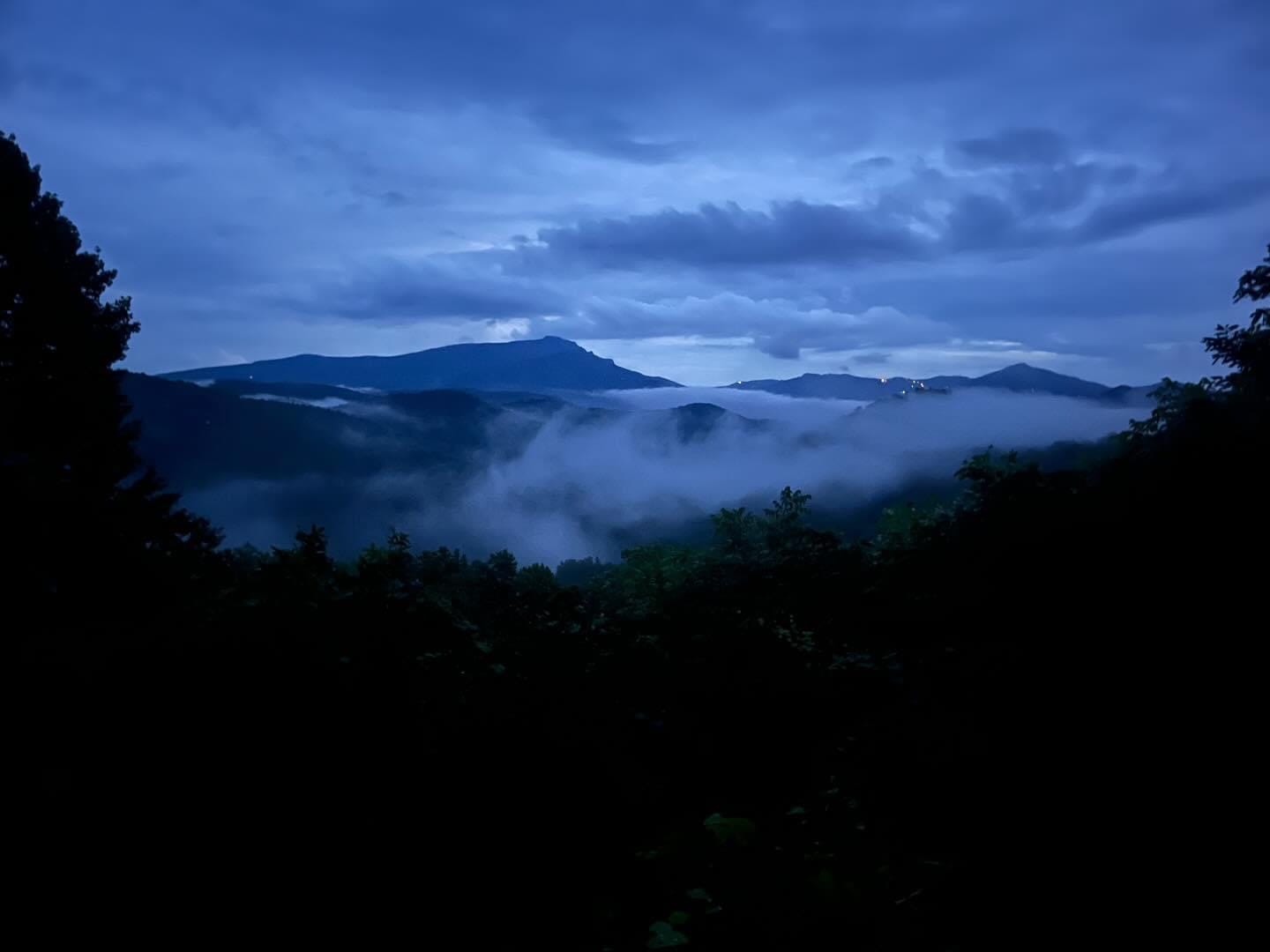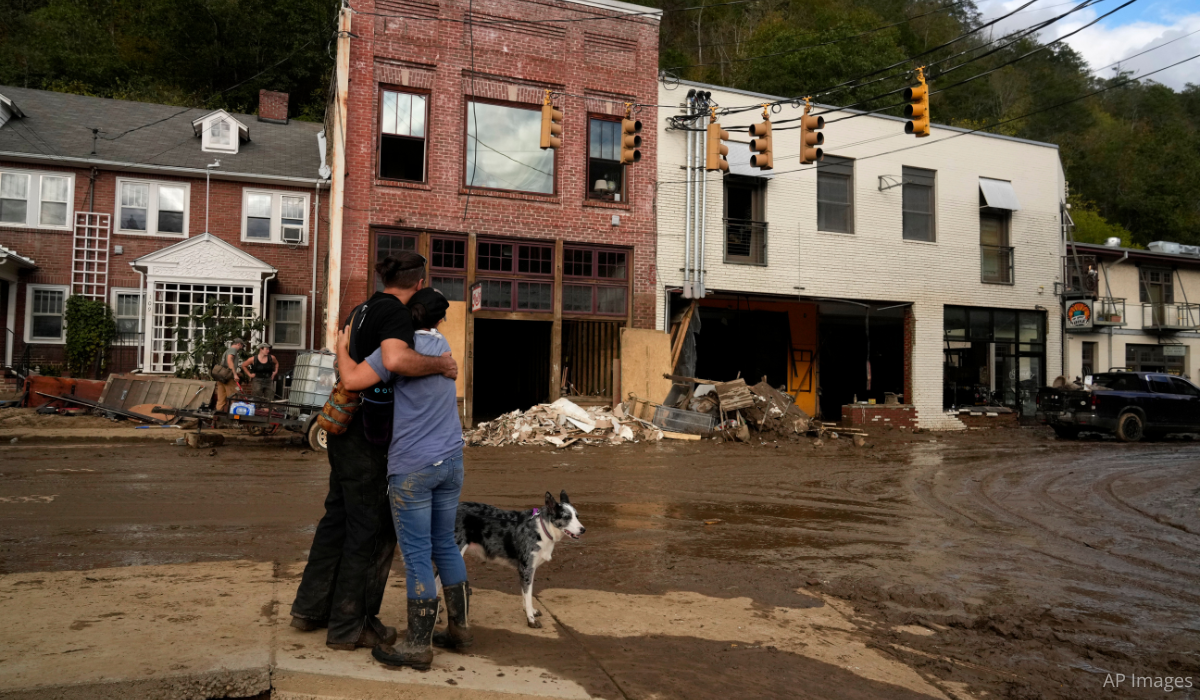Steven Petrow on Helene’s Devastating Impact—and the Best of Humanity He Witnessed In Its Wake
North Carolina is again a swing state, with all the nastiness and divisiveness that comes with that designation. To turn on the television is to be inundated by a tidal wave of political ads that would make anyone head for the hills. Except that our “hills”—the Blue Ridge Mountains, home to communities like Asheville, Boone, and Chimney Rock—were decimated (if not destroyed) in the wake of Hurricane Helene’s “unprecedented” flooding.
As of this writing, more than 100 North Carolinians have perished, according to NBC News, with many more missing and feared dead. Power remains out for hundreds of thousands in the Southeast (with the greatest number of households in the Tar Heel state). “This is not something that’s going to just last weeks,” Zeb Smathers, the mayor of Canton, told CNN Thursday. “We’re going to be having to advocate for these areas in western North Carolina for many, many years.”
@madgfarrier Downtown Chimney Rock, North Carolina “ Wiped out” By Extreme Flash Flood #flood #flooding #flashflood #disaster #severeweather #weather #news #wipedout #extreme #dangerous #emergency #Downtown #ChimneyRock #northcarolina #USA #foryou #viral ♬ Emergency Alarm (Remastered 2015) - Bepo
Since the lights went out in western North Carolina, including at my 99-year-old cabin on a mountain side, I’ve noticed a wholesale change in the landscape. I don’t just mean the creeks and rivers that swept houses away and ripped up the main East-West interstate. There’s been a major shift in the tone and tenor of friends, neighbors, and strangers. Jim Parker, founder of Summit, a design and engineering firm with an office in Asheville, told our local newspaper, The News Of Orange County, that people are coming from everywhere to help those in the mountains. “It’s really amazing. It makes you feel good.”
He’s right, it does. My phone keeps singing with texts announcing new food drives, even for pets, as well as opportunities to volunteer. I’m proud of a neighborhood kid who is now an undergrad at Appalachian State University, which is in Boone, one of the most impacted towns. Eli and friends have been volunteering to deliver water and food to those in need. Let us praise Gen Z!
Another friend, Meighan Carmichael, a real estate agent here in Hillsborough, N.C. (some 200 miles from Asheville), asked friends to contribute supplies to the relief effort, telling us she’d drive them to a local rescue mission. A day later, she reported back: “Thank you neighbors—my car is stuffed to the gills from our impromptu giving. Thank you for sharing. Thank you for taking care of each other.”
Thank you for taking care of each other. Yes, that’s what’s happening.
Meighan is now organizing a second run, and at least two others on her list are doing the same—copycats of the best kind, reminding us that kindness and generosity are as contagious as hate and violence.
While there are some notable exceptions, it’s a truism that the worst situations often bring out the best in people. As entrepreneur and author Bill Taylor wrote in the Harvard Business Review during the Covid-19 pandemic, “In every moment of darkness, it seems, there are countless moments of light—small gestures of compassion and connection that allow people to show who they are, how they want to live, and what matters to them.”
Remember during the pandemic , how hard-boiled New Yorkers came out night after night to hoot and holler, banging on pots and pans to thank health care workers and first responders? That high-decibel expression of community was accompanied on the ground by those making sure elderly neighbors were eating and getting their prescriptions, keeping local restaurants afloat by buying gift cards to help keep cash flowing, and helping scrounge up masks and other personal protective equipment for front-line providers.
In the past week, thousands of first responders from across the United States have traveled to the impacted region—more than 5,000 from FEMA plus untold numbers of others who have simply showed up to help. They are clearing debris, restoring power, handing out food and water, and doing whatever is needed. STIHL, a maker of power tools located in central North Carolina, is donating $10,000 in chainsaws, dispatching five large trucks and 20 team members to get tools to where they are needed to clear blocked roads. Country music superstar Morgan Wallen donated $500,000 to the American Red Cross to help the recovery effort. Lisa Sanders, the owner of Paws at the Corner in Orange County, told me she’s gathering pet supplies to ship to storm-ravaged communities. “Within 24 hours we have received 250 to 300 pounds of dry food and 30 cases of canned food.” When I replied, “That’s a lot,” she texted back, “Yes!!!!! And it’s just the first day!”
I could spend the rest of the day calling out individuals and businesses who have chosen to help. But I was also curious as to why people step up during times of crisis. Rebecca Solnit, in her book A Paradise Built in Hell, studied the impromptu, bottom-up responses to deadly disasters like the 1989 San Francisco earthquake and the September 11 attacks. “The history of disaster,” she writes, “demonstrates that most of us are social animals, hungry for connection, as well as for purpose and meaning.”
Disasters like the current one ask us to join in, act bravely, and give of ourselves or our pocketbooks, no matter our party affiliation, economic circumstances, color, or creed. Stanford psychologist Jamil Zaki has written about disasters and how they produce groundswells of “prosocial behavior” (the opposite of antisocial), characterized by acts of kindness and compassion as well as strong feelings of community or connection.
Survivors in the disaster zone, helping each other day after day, are eroding the usual barriers, making new friends, and reporting a deeper sense of solidarity with each other. Outsiders join in, too, volunteering and making donations. Zaki calls this “catastrophe compassion,” a widespread and consistent phenomenon after natural and man-made disasters.
Still, I’m left with important questions. Why do we have to wait for a tragedy to step up and help each other? And with the region facing a formidable rebuilding project, how do we keep this feeling alive?
My questions point to the same answers: Disasters are often equal opportunity events in that they heighten our sense of individual vulnerability and collective lack of control, almost pushing us into the arms of others who are suddenly more like us than not. Circumstances trump identity. Solnit cites Charles Fritz, a pioneer in disaster research, who put it this way: “[The] merging of individual and societal needs” during a catastrophe “provides a feeling of belonging and a sense of unity rarely achieved under normal circumstances.”
Similarly, Meighan Carmichael, the real estate agent, told me after she’d delivered her first carload of goods, “There’s nothing any of us can do to make this right. But encouraging and connecting with those in need and those in support goes a tremendous way towards building the ties that bind us together.” She added, “This carload feels like the loaves and fishes story … somehow, little by little, everyone putting in a bit of their ‘bread’ and a bit of their ‘fish’ into the baskets, making a meal enough to feed 5,000. The miraculous beauty of working together.”
Curiously, Stanford’s Zaki, author of the new book, Hope for Cynics, actually disagrees with the premise of my questions. He told me it’s mostly “a stereotype” that we quickly return to our worst selves. “During the pandemic, donations to charity, helping strangers, and volunteering increased and remained above pre-pandemic levels for at least two years…. And studies of ‘altruism born of suffering’ find that war-torn communities, for instance, band together over the long term. As long as adversity is front of mind, solidarity tends to be as well.”
As I finish writing this piece, I’m packing up my station wagon to drive to Boone to hand off cases of bottled water, boxes of masks, Pampers, toilet paper, baked beans with bacon bits, and even a couple of boxes of frosted s’mores Pop Tarts, all left on my front porch by friends and strangers seeking to help. Will we be doing the same in a month? In six? I hope we will still be able to say, “Thank you for taking care of each other.”

Steven Petrow is a contributing columnist with The Washington Post and the author of The Joy You Make, published by Maria Shriver’s book imprint, The Open Field. He’s also written three books about modern manners and his TED Talk on civility has been viewed nearly two million times.
Please note that we may receive affiliate commissions from the sales of linked products.



